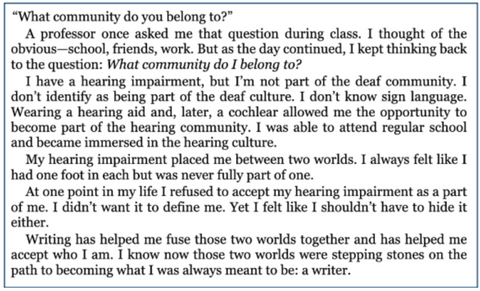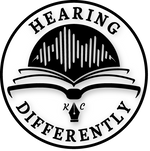When I was in university, I published a book – Hearing Differently: Growing Up With a Cochlear Implant. The beginning of the book had a preface where I pondered a question that my professor had asked me – what community do you belong to?

Reading this preface again reminded me of the identity struggle that I felt while I was growing up. I was someone who was raised as ‘hearing’ but struggled to do just that in almost every environment that I was in. Because of that, I used to think that I was stuck between two worlds, the ‘deaf’ world, and the ‘hearing’ world. Now, with several more years of life experience and education under my belt, I found that my perspective changed.
I no longer think in terms of ‘communities’ but more so in ‘values’. We all live in the same world, but the experiences we have and the people we meet shape our values. I think we should all try and live in a way that is best for us – rather than what other people may think is right for us. This way of thinking also applies to those with hearing loss/deafness.
I spoke with Matt Ayyash and Keegan Noxell. Matt is an American Sign Language (ASL) Instructor at Nova Scotia Community College and a soccer referee. Keegan is a Business Operations Executive at a Canadian company and the Treasurer for the Young Adults Network of the Canadian Hard of Hearing Association. Both have some degree of hearing loss since birth.
One of the big things I learned was that the concept of hearing loss and how people live with it is not black and white – there are so many different types of hearing loss, and so many ways that people deal with that hearing loss, whether it is with hearing aids, cochlear implants, sign language, lip-reading, etc. There is no right or wrong way to deal with hearing loss – the best way depends on the person going through it.
Matt Ayyash
Matt is profoundly deaf and used to wear hearing aids when he was younger, but stopped using them after high school because they were not as effective in helping him hear well, and also caused a lot of headaches and ear infections.
He ended up learning sign language as a teenager and enjoyed it because it helped him communicate better with his peers. As a result of growing up with hearing aids, oral skills, and gestures, he now uses a mix of everything (plus notes/texts) to communicate with hearing people. He says that the moment he stopped using his hearing aids, he felt like “a bird getting out of a cage, being released to freedom”. For Matt, losing his hearing aids led him to find his own identity.
However, he admitted that it was a challenge at times when he couldn’t communicate with hearing people. As Matt grew more accustomed to signing, so did some of the people that he hung out with, which made communicating a lot easier. Despite those challenges, he said that it provided a lot of benefits.
“I learned how to survive in the hearing world through hard times which has gotten me to where I am today. Balance between the hearing world and the Deaf world is important. Another benefit is the ability to communicate with anyone, hearing or Deaf through international gesturing.”
Matt emphasizes the importance of being a part of the hearing world and the Deaf world, stating that he belongs in both, because of the culture and values that both worlds bring to the table.
The turning point in his life as he was struggling with his lack of hearing was when he met the Deaf Canadian soccer team in Ottawa. He compares that experience and the sense of belonging that he felt to “Harry Potter going to Hogwarts with a bunch of wizards”. His experience with the soccer team (as they traveled) helped him learn how to communicate effectively in both the hearing world and the Deaf world.
Personally, as someone who grew up in the hearing world with no exposure to the Deaf community, and relies on their cochlear implant to communicate, this was a fresh perspective – and truly makes me wish that I took the time to learn more about the Deaf culture growing up – but it’s never too late!
Keegan Noxell
Keegan has moderate sloping to severe bilateral hearing loss and wears two behind the ear hearing aids and a Phonak Roger Pen (a wireless microphone that adds clarity in noisy situations and over distance).
He admits that living in a world made for hearing people can be challenging, especially during noisy situations, but he doesn’t feel like he is missing out on much because his way of hearing is all that he has known! However, much like a lot of people with hearing loss, he values smaller groups of people and one-on-one conversations more than the larger crowds. As a result, he sometimes relies on written communication to communicate more effectively with others.
Since he was young, Keegan has been an avid hearing aid user, especially now, since hearing technology has advanced since he first started wearing hearing aids more than 20 years ago. He does admit that while hearing aids provide a great advantage in communicating with the hearing world, “technology has its limitations and we have to be mindful that they don’t address all of the challenges/situations we face”.
Keegan used to be schooled in a classroom with other hard of hearing children, but after Grade 1, Keegan was mainstreamed into the hearing world (being integrated into hearing schooling, culture, etc.), and lost touch with the deaf and hard of hearing community.
“I echo Karina’s feeling of being between two worlds: the hearing and the Deaf community. After being mainstreamed after Grade 1, I grew distant from the hard of hearing community until rediscovering it in my mid-twenties out of interest in connecting with others who understood the challenges (and pros) of living with a hearing loss.”
As his social circle grew to include the hard of hearing community, he admits that he learned a lot, from how members have differing levels of hearing loss to how every person’s experience growing up was unique. Now, like Matt, Keegan sees the benefits of being part of both worlds – and that he can “offer a different perspective that will contribute towards a more inclusive society.”
Keegan’s reintegration back into the hard of hearing community has given him an expanded social circle, a tight-knit group of friends, and “and a greater appreciation for the technology, knowledge, and experiences that come with discovering a community”.
I never had that exposure to the hard of hearing community until I was well into my 20s. I can relate to Keegan’s sentiment that it was nice to connect with people that have had similar challenges as I did when it came to hearing loss. It was also incredible to learn all the different ways people have dealt with their hearing loss growing up.
Thank you to Matt and Keegan for taking the time to share their experiences! I enjoyed learning about both of your different experiences in growing up with hearing loss, and it made me appreciate how each person learned the best way for them to navigate life with hearing loss.

